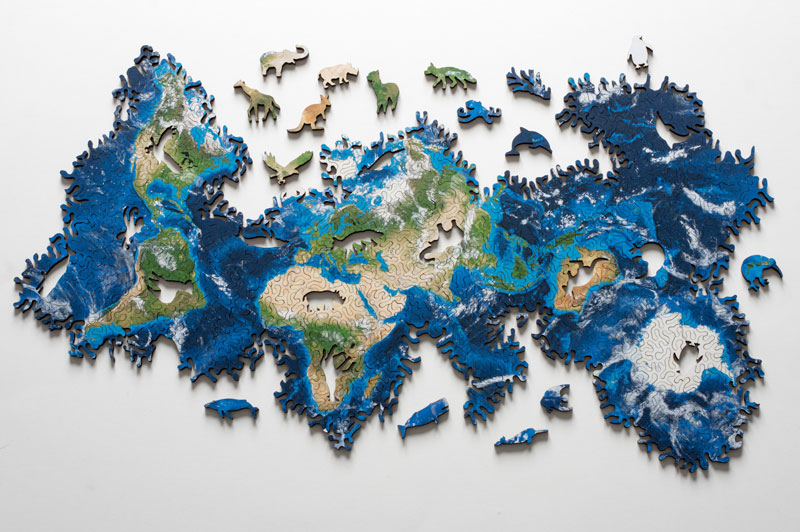
Puzzle by Nervous System
Nervous System has designed this incredible 442-piece, infinity puzzle of Earth with no edges or fixed shape.
Infinitely configurable, this puzzle is based on photographs from NASA’s Earth Observatory and transformed into an area-preserving icosahedral map projection with the topology of a sphere.
Made from laser cut, custom birch plywood, this amazing puzzle is available by Nervous System directly on their website.
Learn more about the puzzle design below. For a more detailed explanation of the design check out this blog post by Nervous System.
[via Kottke]
Puzzle by Nervous System
Puzzle by Nervous System
A classic map imposes distortions and orientations that reflect our preconceived notions of the world. The Mercator projection, which is the map we are most familiar with, unrolls the globe into a rectangle with even spacing of latitude and longitude, inflating Greenland into a massive tundra and smearing Antarctica into an unrecognizable white smudge at the bottom. It makes it seem like the Arctic is impassably vast, when actually flying over it is the fastest way to get to Europe from the US. More subtly, it reinforces the idea of a world split into West and East. Even a true globe typically has a fixed North-South axis, forcing us into a certain viewpoint.
Puzzle by Nervous System
The Earth puzzle is based on type of map called a polyhedral projection, where the sphere is projected onto a shape with planar faces and then unfolded flat. In this case, the globe is projected onto an icosahedron, a 20 sided shape of equilateral triangles. This reduces the distortion seen in most maps.
Puzzle by Nervous System
The vertices of the icosahedron do not lay on land. The vertices are the only fixed point of the puzzle, and a seam must pass through them in order to make the puzzle flat. By putting the vertices in the ocean, it means all continents can be assembled into continuous shapes.
Puzzle by Nervous System
Growing the Puzzle Pieces in 3D: The puzzle piece edges grow, lengthening, until they collide, pushing each other into contorted shapes. Because the puzzle pieces are growing on a 3D surface, Nervous System had to unfold them to a flat pattern so they could be turned into a jigsaw puzzle.
Puzzle by Nervous System
The Earth Puzzle can be assembled into countless shapes because it has the topology of a sphere and pieces wrap around with a rotation.
Puzzle by Nervous System
The Earth Puzzle includes 16 figure pieces shaped like animals indigenous to different parts of the world: a kiwi on New Zealand, an alpaca in South America, a giraffe and rhino in Africa, and different whales and marine animals throughout the ocean.
Puzzle by Nervous System
Puzzle by Nervous System
To learn more about the puzzle and how it was designed, check out this detailed blog post by Nervous System
Puzzle by Nervous System
Puzzle by Nervous System